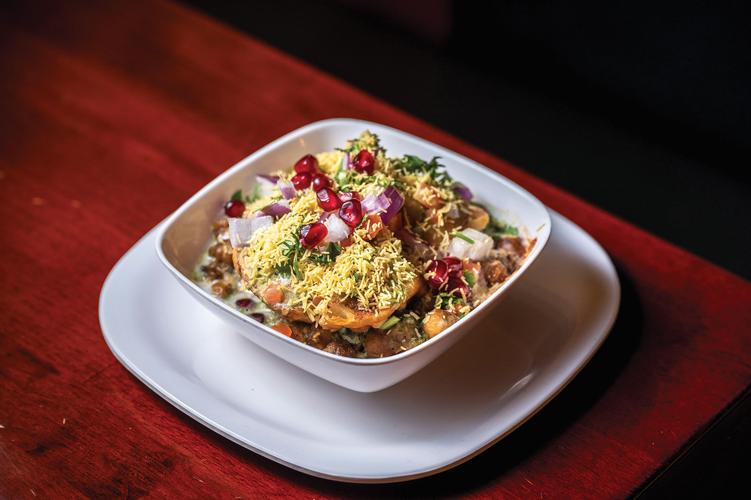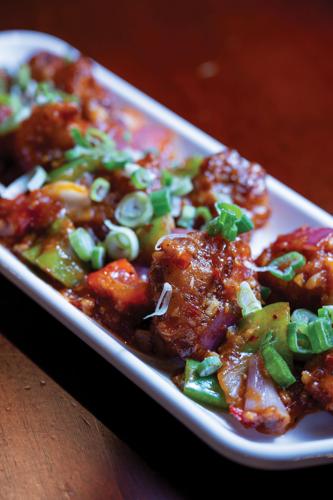When I did a previsit online perusal of Curry & Tikka’s menu, I was impressed by its succinct composition, certainly in comparison to menus at many of the popular Indian restaurants in Nashville. One of those is 10 pages long; another, which numbers items for takeout ordering, counts from 1 to 172; another has 174 options. My eyes glaze over before I’m midway through.
Curry & Tikka, which opened in September in a Kroger-anchored shopping center on East Thompson Lane, comes in at a scant 43, not including eight house-made breads. I like that in a restaurant.
I confess I scoffed at the section titled “India With a Twist,” which includes a burrito, a naanza (yes, a naan pizza), a quesadilla and tikka mac-and-cheese. The food snob in me was skeptical.
The day after eating there — trying eight dishes, two breads and two desserts — I asked my dining companions to send me their favorites. Three out of three cited the tikka mac-and-cheese, with one adding that she hated to admit it. What the hell, I’ll make it unanimous; that pewter serving bowl was scraped clean before it had a chance to cool off.

Tikka mac-and-cheese
Chef-owner Dinesh Jagga explains the vision of the overall menu and the logic behind the items in the twisted section, each of which merges two cuisines. “We wanted to keep the food classical, fresh and simple,” he says. “But at the same time attract people who don’t know Indian cuisine by fusing traditionally Indian ingredients with something familiar.”
The mac-and-cheese begins with large elbow macaroni, ridged to hold the cheese and sauce, cooked al dente. Jagga stirs the pasta with lots of butter and three cheeses, then folds in tikka sauce, charred red peppers and your choice of cubed protein — paneer (if you just can’t get enough cheese) or chicken. It’s the tikka sauce — tomatoes, butter, cream and kasuri methi (dried fenugreek leaves) cooked together for hours — that elevates this particular dish from predictable potluck side to something unique and memorable.
Many Indian restaurants serve the popular Indian street food samosa chaat, which deconstructs the traditional stuffed samosa down to pieces of flaky, fried pastry mixed with an earthy chickpea stew and drizzled with mint chutney. Jagga’s chickpeas are still firm, and crispy broken vermicelli noodles strewn atop add texture, while a generous toss of pomegranate seeds delivers color and an unexpected sweet-sour surprise. That last element fulfills the four S’s that Jagga names as the cornerstones of Indian cuisine — sweet, sour, salty and spicy.
Indo-Chinese food, aka Chindian or Desi-Chinese, finds its origins in Chinese people migrating south to northeastern India, the two cultures producing dishes with flavors and techniques from both countries. Beloved in India, the most popular is gobi Manchurian — labeled cauliflower Manchurian at Curry & Tikka. The dish features floured and fried cauliflower florets, drained then tossed with sweet-spicy Manchurian sauce, topped with sautéed onion and red and green peppers, all the elements of a stir-fry.
Paani puri are always fun: bite-size puffed orbs of puri dough, with a hole cut at the top for a scoop of mashed potatoes, chopped green onion, green chiles and cilantro, served with two small jars of flavored water — mint-jalapeño and tamarind-date — to pour into the puri and quickly pop into your mouth.

Samosa chaat
In India, dal refers to lentil, and makhani to a sauce made with butter and cream; together they create a rich, buttery, creamy-thick soup-stew perfectly suited to spooning over basmati rice or sopped up with torn pieces of soft butter naan or roti. Jagga cooks his black lentils (urad) slow and low for at least six hours in the fire-heated tandoor oven, adding garlic, butter and cream at different stages. The dal makhani is self-served from a small silver pail, finished with more cream and butter.
Tandoori chicken — a generous portion of thighs and legs — is tender, moist and delectable thanks to a double marinade process. A mix of salt and lemon (acid) breaks down and softens the tissue of the raw meat; then a thick mix of yogurt, ginger-garlic paste, garam masala, turmeric, red chile powder and kasuri methi adds subtle heat and deep flavor all the way down to the bone. Cooked to a char in the tandoor oven, it’s plated on a bed of sautéed red onion and served with mint-coriander chutney and lime wedges for spritzing. Eat straight from the bone or pull some off and wrap it in a piece of naan.
I’m a fan of biryani — a basmati rice dish with roots in Iran or Pakistan — and goat, so I was sorely disappointed in the goat dum biryani, the only failure of the meal. The rice was cooked and seasoned exactly right, but the pieces of goat meat were so tough they were inedible. Jagga says he is having trouble finding a good goat purveyor; as dedicated to quality of ingredients as he shows himself to be, the error should be corrected by removing goat from the menu rather than serving an inferior product. I wished we had ordered the chicken biryani instead, or the tandoori lamb chops, or the Malabar fish curry, or the jheenga mango — shrimp cooked in creamy tomato sauce with mango.

Cauliflower Manchurian
Though we were perfectly sated by the meal, professional duty compelled us to order two desserts, both thankfully small. We preferred the gulab jamun — two small, golden balls of milk dough flavored with rose water and cardamom, deep-fried and anchored in a pool of sweet syrup — to the other dessert we tried: kulfi falooda, a not quite coherent mix of Indian ice cream (kulfi), vermicelli (falooda), rose syrup, milk and basil seeds.
Jagga is still plowing through the red tape involved in getting wine and beer permits, but guests can bring their own for a small ($5) corkage fee. Decor is minimal though pleasant, and the seating in leather-upholstered booths and chairs is quite comfortable. A lunch buffet, the mainstay of every Indian restaurant, is available every day but Tuesday — when the restaurant is closed — from 11:30 a.m. to 2:30 p.m.
The young chef — just five years in America after graduating from the Culinary Academy of India and arriving in Nashville to cook at the Marriott — is imbued with talent and passion, eager to come out of the kitchen into the dining room to say hello, full of energy and ideas. He offers Tesla owners who charge their vehicles at the station across the street a 10 percent discount if they’d like to eat while they wait.
If you own a Tesla, you probably don’t need a discount on your check. You can bike, bus or drive your old jalopy to Curry & Tikka, and frankly, you won’t need a discount either. The buffet is just $14.99 per person/$11.99 for kids, and four of us ate more than our share à la carte for just over $100.
You probably won’t go to Curry & Tikka Indian Restaurant for the mac-and-cheese, but having had it, I’d be lying if I didn’t admit I’ll go back for it.






